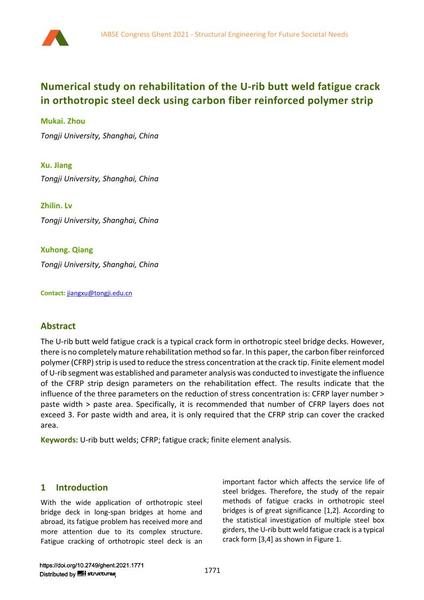Numerical study on rehabilitation of the U-rib butt weld fatigue crack in orthotropic steel deck using carbon fiber reinforced polymer strip

|
|
|||||||||||
Bibliografische Angaben
| Autor(en): |
Mukai Zhou
(Tongji University, Shanghai, China)
Jiang Xu (Tongji University, Shanghai, China) Zhilin Lv (Tongji University, Shanghai, China) Xuhong Qiang (Tongji University, Shanghai, China) |
||||
|---|---|---|---|---|---|
| Medium: | Tagungsbeitrag | ||||
| Sprache(n): | Englisch | ||||
| Tagung: | IABSE Congress: Structural Engineering for Future Societal Needs, Ghent, Belgium, 22-24 September 2021 | ||||
| Veröffentlicht in: | IABSE Congress Ghent 2021 | ||||
|
|||||
| Seite(n): | 1771-1777 | ||||
| Anzahl der Seiten (im PDF): | 7 | ||||
| DOI: | 10.2749/ghent.2021.1771 | ||||
| Abstrakt: |
The U-rib butt weld fatigue crack is a typical crack form in orthotropic steel bridge decks. However, there is no completely mature rehabilitation method so far. In this paper, the carbon fiber reinforced polymer (CFRP) strip is used to reduce the stress concentration at the crack tip. Finite element model of U-rib segment was established and parameter analysis was conducted to investigate the influence of the CFRP strip design parameters on the rehabilitation effect. The results indicate that the influence of the three parameters on the reduction of stress concentration is: CFRP layer number > paste width > paste area. Specifically, it is recommended that number of CFRP layers does not exceed 3. For paste width and area, it is only required that the CFRP strip can cover the cracked area. |
||||
| Stichwörter: |
Finite-Elemente-Analyse Ermüdungsriß CFRP
|
||||
| Copyright: | © 2021 International Association for Bridge and Structural Engineering (IABSE) | ||||
| Lizenz: | Die Urheberrechte (Copyright) für dieses Werk sind rechtlich geschützt. Es darf nicht ohne die Zustimmung des Autors/der Autorin oder Rechteinhabers/-in weiter benutzt werden. |
||||
